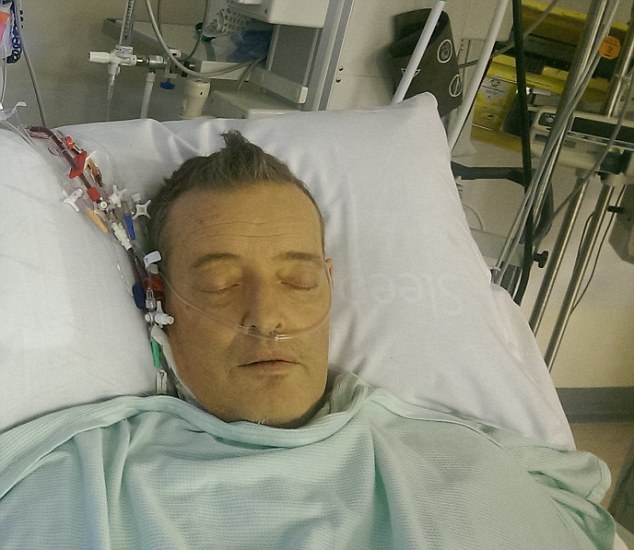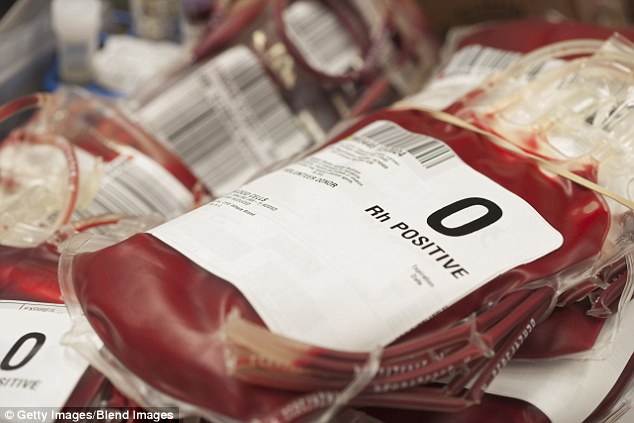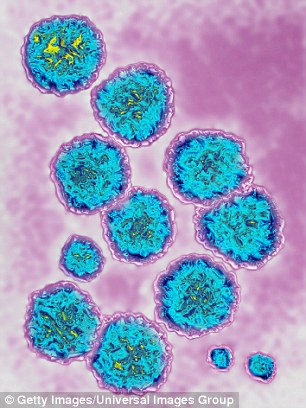
Hepatitis C Infected blood plot
"Modern Medicine would rather you die using its remedies than live by using what physicians call quackery".--Dr Robert Mendelsohn, M.D.
[See: [2010 Aug Video] Swine Flu Cure using Vitamin C Therapy re letting you die. They haven't even proven Hepatitis C virus exists, and it's curable with Vit C but that isn't Big Pharma/Drug medicine. They also have been caught deliberately using Infected blood, it's all part of their State Abuse and State Genocide rackets]
A betrayal to make you weep: That 1,800 Britons have been 'murdered' by tainted NHS blood is bad enough, but the grotesque way the victims have been denied justice is the scandal of our age
By Guy Adams for the Daily Mail
11 April 2015
Mike Dorricott died a week ago yesterday at the Freeman Hospital in Newcastle, in a room filled with those he loved most: his mum Jennifer, sister Jane, wife Ann and their grown-up daughters Sarah and Ellie.
Aged just 47, he had spent his final days propped up in bed with tubes up his nose, drifting in and out of consciousness. His kidneys and liver were failing, his stomach and lungs were infected and he was in the terminal stages of liver cancer.
When the end came, early that morning, it felt almost like a release. Mike’s skin had long since turned yellow from liver failure, and he could no longer breathe unaided. A larger-than-life character known for his wicked smile and cheeky laugh, he had been reduced first to speaking in a whisper, then not speaking at all.
‘Mike died peacefully,’ says a close friend, Sue Threakall. ‘He was a wonderful man and they made sure he was told about all the people thinking of him and praying for him. He knew how much he was loved.’

Mike Dorricott lies dying, at just 47, of liver cancer having contracted hepatitis C from contaminated NHS blood
It was, to all outward appearances, a dignified and peaceful farewell. Yet along with the sorrow there was also a real anger in that room, which continues to this day. For an appalling sense of injustice overshadowed Mr Dorricott’s fate.
It stretched back to 1996, when Mike, a successful businessman who lived in the Surrey commuter belt, had received life-changing news.
A blood test, ordered by his doctor after he complained of fatigue, revealed that he had hepatitis C, an incurable virus which causes long-term damage to major organs.
The condition, known as ‘the silent killer’ because it can lie undetected for years, had already left him with severe cirrhosis, an irreversible scarring of the liver (often suffered by alcoholics). Without a transplant, Mike was likely to be dead in a few years. Even with one, his life would be seriously curtailed.
The hepatitis wasn’t just a case of simple bad luck. As Mike would soon discover, he had just become the latest blameless victim of perhaps the most egregious public scandal in modern British history.
At its centre was contaminated blood — or, more accurately, contaminated blood products.
Between 1970 and 1991, against the recommendation of many experts, the NHS routinely imported such products from overseas.
It would later emerge that many of them were supplied by drug companies that sourced blood by paying people in high-risk groups, such as prostitutes, vagrants and drug addicts, to donate it. The products were riddled with the blood-borne viruses hepatitis C and HIV.
In a second terrible oversight, these highly dangerous products were then administered to British patients without being screened for the viruses, despite warnings from the World Health Organisation. Innocent patients were duly infected as a result. About 7,500 people, of whom roughly two-thirds were haemophiliacs, are now known to have been given hepatitis C during this period.

Mr Dorricott with his daughter Ellie. He was a successful businessman living in the Surrey commuter belt when he was told he had hepatitis C in 1996
Many are no longer with us, including Body Shop founder Dame Anita Roddick, who was infected by a blood transfusion after the birth of her daughter Sam in 1971. She died in 2007, aged 64, from a brain haemorrhage caused by the disease. According to an estimate by MPs, who debated the scandal in January, as many as 35,000 victims could have hepatitis C, which is often undetected for years, without yet being aware of it.
Around 1,500 of the 7,500 confirmed hepatitis victims have also contracted HIV. Many then unwittingly passed it to their spouses. In the Eighties, when most of these transmissions occurred, Aids was a virtual death sentence. Three-quarters of them died.
More than 1,800 people have so far lost their lives from contaminated NHS blood. Mike, a mild haemophiliac who was given a blood-clotting product called Factor VIII during a childhood hospital visit, is the most recent addition to their tragic ranks.
By death toll alone, this makes it the biggest man-made disaster in postwar British history. Indeed, the leading medical scientist Lord Winston has called contaminated blood ‘the worst treatment scandal in the history of the NHS’.
Numbers are only part of the terrible picture, however. For, as the Dorricott family and thousands like them will tell you, the most shameful aspect of this entirely preventable tragedy has been the appallingly shabby treatment of victims.
Having been betrayed by the greed of drug companies that sold the blood which infected them, and the incompetence of public officials who purchased it, these innocent victims have faced years of cover-up and obfuscation by the very institutions that failed them.
A culture of heartlessness and an abject refusal, across several tiers of government, to accept responsibility has resulted in thousands of childhoods ruined, families destroyed and careers derailed.

Pouches of donated blood. Between 1970 and 1991, against the recommendation of many experts, the NHS routinely imported contaminated blood products from overseas
Many of these blameless men and women, already facing terminal illness, have suffered the indignity of being forced into financial hardship by their condition, without being adequately compensated by the governments that caused it.
Mike, formerly a high-flying executive with United Biscuits, is a case in point. In 2008, he found himself physically unable to work after having a second liver transplant.
Then, at the age of just 40, having worked hard all his adult life, he was forced to forgo his comfortable salary for a relatively tiny pension that meant he was unable to service his mortgage. The family house in Farnham was sold and the Dorricotts moved to a smaller home in Yorkshire. The inheritance he had dreamt of leaving to his children disappeared.
‘I won’t be there for my wife and daughters,’ he said, shortly before his death. ‘I won’t get to walk them up the aisle. I won’t be there to see our grandchildren. My wife will be on her own. The only thing that might mitigate this is a financial package, from the Government, that makes my family secure for the future.’
But no such package has ever been provided. Unlike in Ireland, where victims were individually assessed for losses and have received an estimated average of £275,000 each, Britain has provided only some of those given terminal illnesses by contaminated blood with payments, of between £20,000 and £63,000 — provided strict conditions were fulfilled.
To access funds, claimants must go through a humiliating and often baffling process of applying for grants or payments from one of five confusingly organised quangos and charitable trusts, in a system recently described by MPs as ‘not fit for purpose’.
Unlike in France, Canada and Japan, not one bungling official has been prosecuted, held to account or named as being responsible. Successive governments have failed to apologise to the victims or offer adequate compensations.
While other national tragedies, from Bloody Sunday to Hillsborough, have been the subject of hard-hitting and expensive official inquiries, successive health secretaries have refused to hold a proper investigation into contaminated blood. Only in Scotland has even the slightest effort been made to hold officials to account.

Body Shop founder Dame Anita Roddick was infected with hepatitis C by a blood transfusion after the birth of her daughter Sam in 1971. She died in 2007, aged 64, from a brain haemorrhage caused by the disease
There, a six-year investigation by Lord Penrose, a judge best known for conducting the public inquiry into the Equitable Life scandal, was published last month. It cost almost £12 million and ran to 1,800 pages, but was immediately dubbed a ‘whitewash’ by campaigners, who walked out of its unveiling and promptly burnt a copy in front of TV crews.
Penrose did not apportion any blame and made just one recommendation: that people who felt at risk should be tested for hepatitis. He said bungling officials should be judged ‘by conditions that prevailed at the time’ rather than by today’s standards.
Take, in this context, the experience of Tony Farrugia, now a married father-of-three from Cambridgeshire, who lost his father Barry and two uncles, Victor and Dave — who all suffered from haemophilia — to viruses contracted from tainted blood-clotting product Factor VIII. Tony was 13 years old in 1984 when his dad learnt he had hepatitis C — and 14 when his father was also declared HIV positive. Barry died of Aids the next year, aged just 37, when Tony was 15.

The hepatitis C virus. The incurable disease causes long-term damage to major organs
Days later, social workers arrived at the family home and took Tony and his twin brother David (who were estranged from their natural mother) into care. The bereaved boys were then sent to separate homes, more than 100 miles apart. It would be a decade before they were reunited.
‘It caused so much hurt and pain,’ says Tony. ‘A family was split up because of this. We’ve never had an apology, or any formal support from the government. I’ve applied for help and been rejected every time. There has been no compensation for the years we lost. I was only given counselling last year. It’s a betrayal.’
How does Tony feel at being told his experience was a natural by-product of ‘conditions that prevailed’ at the time?
‘Revolted,’ he says.
Or consider the case of Sally Vickers, a 54-year-old former civil servant from Portsmouth, who was infected with hepatitis C during a blood transfusion in the early Eighties.
She now has severe rheumatoid arthritis and cirrhosis of the liver from the condition, lives in acute pain and has been unable to work since the late Nineties. Once an independent career woman, today she lives on benefits in a one-bedroom council flat.
‘I can’t stand not working. I’m not a lazy person, it’s just a terribly debilitating disease,’ she says. ‘Ten years ago I was given eight years to live. I’m 54 and already on borrowed time. Well, it just sucks.’
Hepatitis C, which struck in her 20s, prevented her from having children. She would love to travel in what remains of her life, but even if she could afford a holiday the condition has left her unable to get insurance. ‘It has robbed me of so much, and I’ve had nothing in return,’ she says.
There are hundreds like Tony and Sally, and their tales are all heartbreaking. Speak to some of them, as I did this week, and you will be saddened and outraged in roughly equal measure.
The scandal that sealed their fates stretches back to the early Seventies when health officials, faced with increased demand for blood products because of medical advances, decided to start importing them from the U.S. and Canada.

Former US President Bill Clinton, who was governor of Arkansas when prisons there developed a multimillion-dollar industry by selling inmates' blood
This posed obvious dangers. Under UK law, blood donation was (and still is) required to be voluntary rather than paid-for, to prevent people from high-risk groups who are desperate for cash from signing up. Yet the NHS’s new commercial suppliers were all paying for their product.
Officials nonetheless chose to approve the imports. So, across the Atlantic, drug firms began sourcing blood from wherever they could find someone in need of a fast buck.
Some of these new NHS suppliers created so-called ‘skid row’ donor clinics, frequented by drug addicts, vagrants and prostitutes. Others set up shop in Haitian slums. One Canadian company even took blood extracted from Russian corpses and re-labelled it as having come from Scandinavian donors.
In the U.S. state of Arkansas, then governed by Bill Clinton, who now tours the world promoting Aids prevention, prisons developed a multimillion-dollar industry by selling prisoners’ blood.
Inmates were paid a small amount for giving blood twice a week. They were like ‘little cows’, one Clinton aide said later.
It is hard to think of a more high-risk group. Yet their tainted blood flowed into Britain for years, despite apparent efforts to stem the trade.
As early as 1975, Lord Owen, then Health Secretary, became concerned about imported blood and told the House of Commons that he wanted the NHS to be ‘self-sufficient as soon as possible’. But civil servants failed to act.
By the late Seventies, NHS officials were slowly becoming aware of viruses in their donor pool. But they did little to ensure public safety. In May 1983, researchers warned the Department of Health that it should ban U.S. imports of blood-clotting agents. The warning was never followed up.
In August that year, the first recorded haemophiliac died from Aids. Yet countless patients continued to be infected. Although the U.S. finally banned prison blood in 1984, exports were allowed to continue and, incredibly, the NHS continued to buy it.

As early as 1975, Lord Owen, then Health Secretary, became concerned about imported blood and told the House of Commons that he wanted the NHS to be ‘self-sufficient as soon as possible’
Even when safer, heat-treated products were introduced in the late Eighties, NHS doctors were allowed to choose whether they wanted to use them. Many decided to use up old, contaminated supplies first. Hundreds more people died as a result.
Britain didn’t start to screen blood properly until 1991. By then, at least 16 Western countries had already acted. Again, no apology or explanation for this oversight has ever been made.
Equally appalling in the 25 years this scandal has been public knowledge has been the abject failure by all governments to try to put things right.
Officials have also displayed appalling heartlessness.
One Department of Health memo, leaked five years ago, showed civil servants attempting to work out how to spend the money the NHS might save from the deaths of hundreds of haemophiliacs (whom they appeared to regard as a drain on resources). ‘Of course, the maintenance of the life of a haemophiliac is itself expensive,’ it began. ‘Those who are already doomed will generate savings which more than cover the cost of testing blood donations.’
Vaccines that could have prevented deaths were ruled too expensive. Paperwork was lost. Repeated calls for public inquiries were rejected on cost grounds.

Caroline Flint, then Public Health Minister, caused outrage by claiming key documents detailing the contaminated blood scandal had been destroyed ‘in error’ by a junior member of staff
Then, after victims set up a privately funded one in 2007, the Department of Health withheld vital papers, citing confidentiality, and refused to give evidence.
A couple of years later, Caroline Flint, then Public Health Minister, caused further outrage by claiming that key documents detailing the scandal had been destroyed ‘in error’ by a junior member of staff.
Several victims who have tried to sue also found that crucial medical records had gone suspiciously missing.
Joseph Peaty was one of 75 pupils at Lord Mayor Treloar College, an experimental boarding school in Hampshire for people with haemophilia, where all pupils were regularly given Factor VIII. He and almost all his peers contracted HIV, and 46 are now dead.
‘A few years ago I discovered that they still had frozen blood samples from school, so I decided to get them tested to find out when exactly I contracted HIV,’ he says.
‘At first I was told that it was too costly. Then, after I got the money together, they told me the samples had mysteriously vanished.
‘It is symptomatic of the utter disrespect with which we have all been treated.’
For the past six years, many victims have clung to the hope that Lord Penrose’s report would give them what passes for closure, and lead to a formal government apology and a proper compensation package for them and their loved ones. Again, they have been cruelly disappointed.
Mike Dorricott, like so many before him, took that disappointment to his grave. Two days before he died, he telephoned his friend Sue Threakall to ask about the report’s long-awaited publication.
‘Although Mike struggled to speak, it was clear that even at this stage all he wanted to know was whether the Government had finally agreed on proper compensation so that he could die with peace of mind, knowing his family would have the financial security that contaminated blood had taken away from them,’ she says.
‘I couldn’t tell my lovely, brave friend the truth — that there was no compensation, no guarantee of security. Instead, I said simply that some money had been allocated pending a proper settlement. Whether he fully understood this I have no idea.’
And so, for thousands like Mike, the betrayal continues.
Read more: http://www.dailymail.co.uk/news/article-3034412/1-800-Britons-murdered-tainted-NHS-blood-denied-justice-scandal-age.html#ixzz4dVHNIAEF
Follow us: @MailOnline
on Twitter | DailyMail
on Facebook